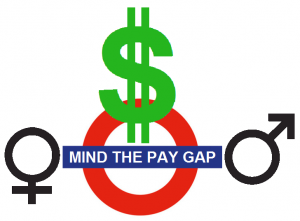By Roberta Attanasio, Forever Leaders Editor
More than 50 years ago, President John F. Kennedy signed the Equal Pay Act of 1963. In his remarks upon signing the Act, he said: “I am delighted today to approve the Equal Pay Act of 1963, which prohibits arbitrary discrimination against women in the payment of wages. This act represents many years of effort by labor, management, and several private organizations unassociated with labor or management, to call attention to the unconscionable practice of paying female employees less wages than male employees for the same job.”

Image credit: Mike Licht, CC BY 2.0
However, despite the increased attention placed on this “unconscionable practice”, the gender pay gap is still alive and well in all 50 states. According to the American Association of University Women, the gap has narrowed since the 1970s, but progress has stalled in recent years, and the pay gap does not appear likely to go away on its own. In 2014, women working full time in the United States typically were paid just 79 percent of what men were paid—a gap of 21 percent.
Indeed, gender differences in salaries exist in many different professional environments. Here is a case in point. Results from a new study (Sex differences in physician salary in US public medical schools) published in a major medical journal (JAMA Internal Medicine) show that, on average, female academic physicians earn nearly $20,000 less a year than their male colleagues—”Among physicians with faculty appointments at 24 U.S. public medical schools, significant sex differences in salary exist even after accounting for age, experience, specialty, faculty rank, and measures of research productivity and clinical revenue.” Remarkably, salaries for female full professors were comparable to those of male associate professors.
The study was based on the analysis of more than 10,000 physician faculty members at 24 medical schools. Women physicians in the study were less likely than men to be full professors, and tended to be younger. When compared to men, more women specialized in internal medicine, obstetrics and gynecology, and pediatrics. Women also had fewer total publications, were less likely to have funding from the National Institutes of Health, and less likely to have conducted a clinical trial.
Interestingly, the researchers found significant salary gap variations in different specialties and in different medical schools. For example, while surgical specialties had the largest sex differences in salaries, women in radiology did not experience a pay gap. Similarly, in two of the schools included in the study, there were no differences in income by sex.
What is the practical value of these results? Although probably the study validates what women academic physician have always known, it also provides the basis for transparent discussion nested in unequivocal data. In an accompanying editorial, Vineet Arora, an associate professor of medicine at the University of Chicago, wrote: “Fixing the pay gap between male and female physicians in academic medicine requires more than just studies showing that it exists; concerted efforts are needed to understand and eliminate the gap.” In addition, she told The New York Times: “This paper is going to make women academic physicians start a conversation with their institutions to promote transparency and gender equality, because at the end of the day, it’s not fair.”
Copyright © 2016-2018 Forever Leaders.




At this point, it seems that the institutions of racism and sexism are set in place and will not be knocked down for quite some time. Highly-educated women in the sciences, medicine, business, etc., are still subjected to unequal pay and treatment and I feel that at this point more efforts should be taken to put women in positions where they have a louder voice against sexism in the workplace. The pay gap seems to not only stem from socialized sexism but also in the lack of voice that women have in the workings of their careers. Years upon years of submission have been heaped upon the professional stride of women and it is important that we break this mode of thinking, first before trying to tackle the beast that is socialized sexism.
I know I would like to be an Orthopedic Surgeon. Current articles suggests that women in this field on average get paid 40,000 less than men. I don’t want to imagine what the gap is like for minority women. My question is how can such a large gap exist without a conversation? My theory is that women just starting in the Orthopedic field. There are also a larger number of experienced surgeons who are male than woman surgeons. I say this to say a contributory cause is that women are just now getting their feet wet in becoming such a surgeon. I feel the other part comes from lack of discussion. I certainly believe articles and research that focus on this situation will start the conversation which in turn will have a large impact on the gap.
It’s interesting to see that 53 years after the Equal Pay Act was passed, there is still such a drastic pay gap between males and females. A million questions are running through my mind. One being how is this possible if there is a law to prevent pay discrimination? The only plausible conclusion I have ever been able to come to is that we, as women, simply do not ask for what we deserve. Also, we would never realistically know (without reading research) that we were making less than men because discussing pay with colleagues isn’t something you are supposed to do. It’s almost as if we play it safe because we don’t want to seem cocky or full of it because it’s just not lady like…even though we truly do know our worth. There is obviously no biological difference in work ethic between men and women, so what’s the problem?
I don’t know if it is a discriminatory action to hire a woman knowing her asking wage is noticeably less than a comparable man at a place of business; or is it just a smart move by the person doing the hiring to agree to the lower price for the good of the business? I mean, at the end of the day a business is a business…and any money not used to pay employees can be reallocated for another purpose. That purpose could very well be to pay another man more.
I was wondering the same thing Ashley. Even in Canada the gender pay gap is an issue. In Canada, women workers earn an average of 72 cents for every dollar earned by men. Compared to the United States, that is a full 8 cents lower. I agree that women are scared to ask for a higher pay. They do not want to be perceived as gold diggers and lazy. We sometimes underestimate our worth, our value; thus, many employers will take advantage of such and work it for their gain. On the other hand, I have heard of women who purposely take the low paying job so that they can work themselves to the top. No matter the reason, it is still a problem awaiting a solution. To solve this solution, I know many peers who apply for jobs under “manly” names. Some even go as far as to legally change their name. Others do their best to dress, talk, and walk like men. Personally, I am worried that these options may develop into permanent solutions, in which we will have to destroy individuality to follow the status quo.
[…] research confirms a persistent gender pay gap in Medicine. Results from a study published a few months ago show that female academic physicians earn nearly $20,000 less a year […]